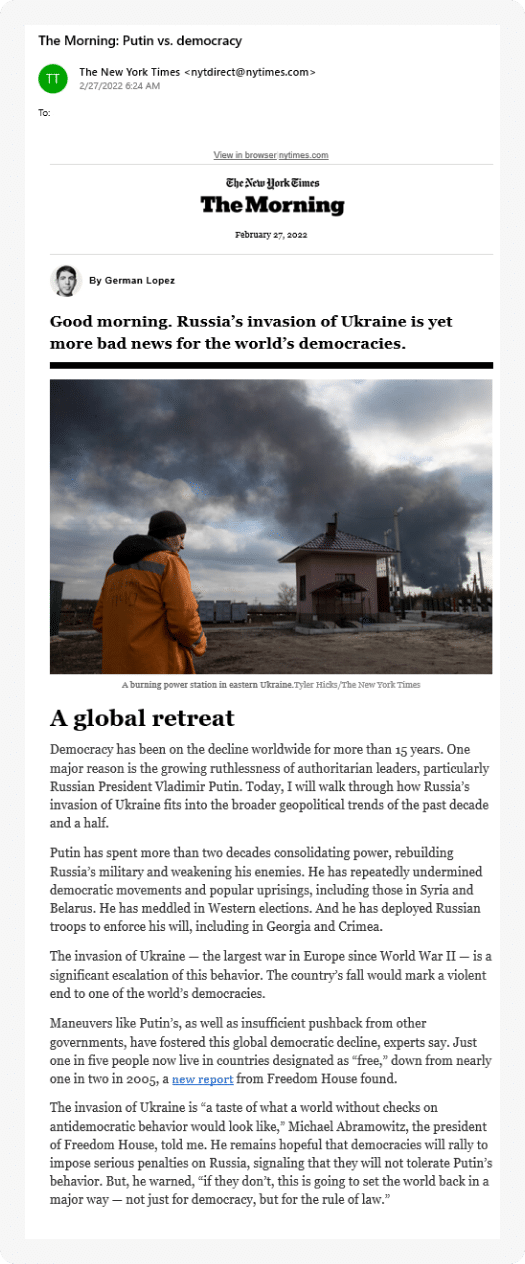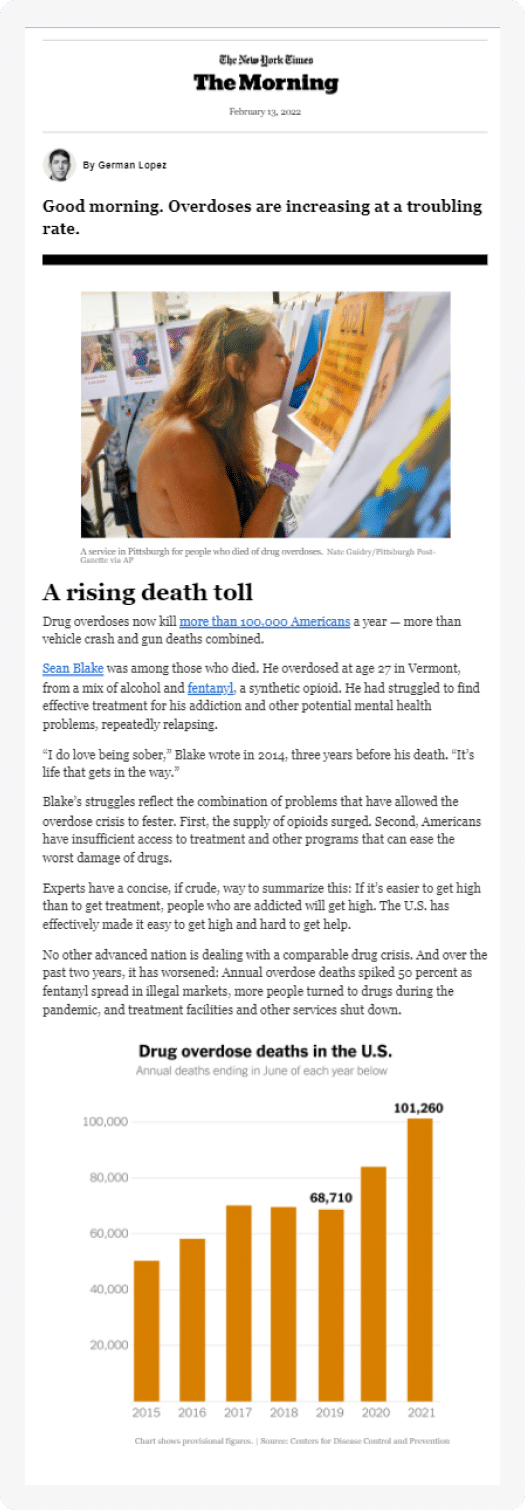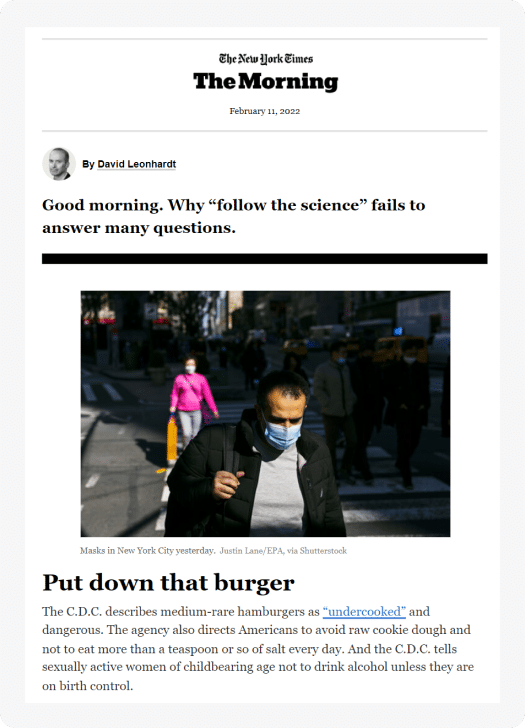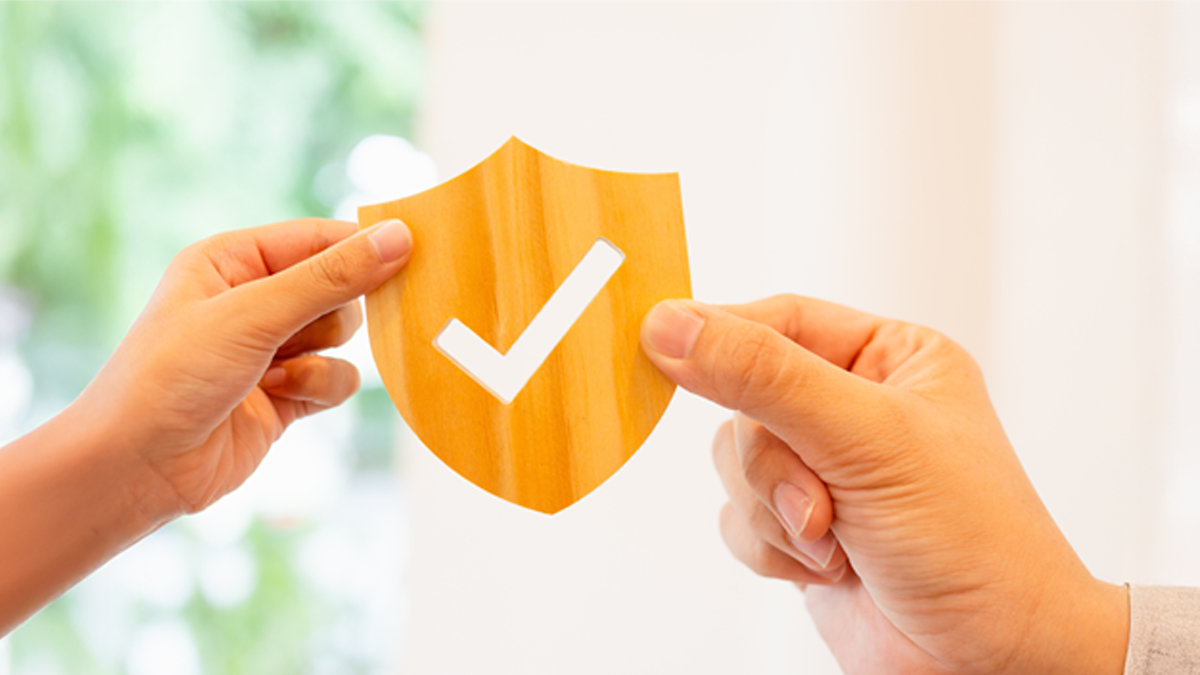
Let’s break down the secrets to success behind The New York Times’ The Morning, and what you can learn from it for your own newsletter.
Some people say newspapers are dead, but The New York Times (NYT) isn’t taking that lying down. It has maintained its classic brand and award-winning content while evolving its product to serve a digital audience. Besides its website that serves as a digital news source for its readers, it has curated one of the most popular daily email newsletters in the world. The newsletter, called The Morning, has garnered over 17 million subscribers.
So, how has The New York Times built a newsletter subscriber list over twice the population of New York City? It took the strengths of its centurial newspaper and adapted them to a new platform. It translated attention-grabbing headlines into subject lines. It adapted award-winning photojournalism into newsletter illustrations. And it turned renowned news stories into a newsletter its subscribers eagerly wait for each morning.
While your organization may not be an iconic newspaper, you can apply many of the same principles The New York Times has used to build your own successful newsletter. That is, a newsletter that is engaging and informative, keeps your readers coming back, and ultimately promotes your brand to a captivated audience.
1. Short, intriguing subject lines
Eye-catching newspaper headlines have been a long-standing tradition in the world of journalism, a skill The New York Times has leveraged in its email newsletter subject lines. The Morning features succinct subject lines with compelling descriptions you can’t help but want to open.
The Morning email subject lines are typically no more than four words following the title of the newsletter. They offer enough for the reader to know what the featured story is about but hold back the details, so the reader has to click to find the resolution.
Don’t worry — even if you don’t have harrowing war stories or political unrest to share in your newsletter, you can still curate eye-catching headlines. Start with determining a distinct perspective or value to share with your readers. From there, isolate the most essential concepts or words and think about the goals of your customer.
For example, if your value proposition is a 50% off sale on summer clothing, don’t just share a deadpan subject line that says, “we have a sale.” Instead, offer your customer the tangible and aspirational value of the sale in your subject line. For example, your subject line could be “50% Off Summer Fashion Statements!” This highlights the savings value as well as the goal they can attain by participating (making a fashion statement).

Source. In this issue of The Morning, the subject line only uses two words (and an abbreviation) following the title of the newsletter. And yet, just those couple of words create a striking image in the mind of the reader.
2. Vivid imagery
The first thing you see when you open The Morning is an in-your-face graphic or image. Let’s just say The New York Times definitely takes advantage of its award-winning photojournalists and designers when it comes to producing its newsletter. The image immediately conjures an emotion, making the reader invested right from the start.
The opening graphic in your email newsletter is like the welcome mat to the narrative you create within. Make sure it invites your readers in and tells them what they can expect. Maybe it says, “groundbreaking news” or “innovative ideas.” Or maybe it says, “If you’re pizza, Amazon, or Ryan Gosling, I’m home” (our favorite).

Source. The striking image of grieving loved ones puts a face to the opioid crisis, driving home the individual impact of the headline.
3. Clear sections and clean design
The Morning makes it clear what its readers can expect in each section with descriptive section headers and clear dividing lines. The simple black and white print is not only reminiscent of its newspaper roots but also makes its content easily legible.
So maybe a straightforward black-and-white design doesn’t fit your brand or audience but maintaining legibility is still key. This includes taking into account the 49% of users reading email on a mobile device. Are your emails optimized for mobile? Is your content skimmable? Is the contrast between the font and background stark enough that it’s easy to read?

Source. Each The Morning newsletter opens with a header, the author’s name, and then the lead story, separated by a thick dividing line. Similarly, the rest of the newsletter is broken into sections by a thick black line and section title. The sections are divided by news, opinion pieces, books, Times Magazine content, and games, so the reader can easily skip to the sections that interest them the most.
4. Timely and comprehensive content
The Morning gives readers everything they need to carry on conversations about culture and world events. It features events that are happening currently but also provides resources to understand upcoming news-worthy topics. The newsletter also explores cultural moments in time such as food, literature, art, and entertainment.
Even if your business is not reporting the news, it’s worth taking a note from The New York Times when it comes to timeliness cultural relevance in your content. This might look like making sure your promotions are in line with current holidays, your event reminders give your audience enough notice to act, and your voice and tone are in line with cultural trends.

Source. The Morning features a headlining story each day that highlights a major current event before moving into the culture and entertainment sections. No need to wonder what everyone is talking about around the water cooler when you get The Morning every … well, morning.
5. Authoritative voice and tone
Even the most renowned newspapers in the world have to maintain authority and trust with their readership. Most major news organizations try to distance their journalists from their work to promote the idea of unbiased news. However, The New York Times takes a unique stance in its newsletter by having each one “hosted” by one of its renowned journalists. This builds a personal connection with the reader and establishes trust and credibility by having a respected name on the byline.
In addition to naming the writer, the content is written in a strong authoritative voice and tone. There are no qualifying statements or punches pulled; the writers take a clear stance in every issue.
You may not be a leader in political or cultural opinion, but you do have the opportunity to be an authoritative voice in your industry niche. Own your space, take a stance on industry practices or trends, and challenge the status quo. Make a statement your readers will not only remember you for but come back for.

Source. The New York Times is not above questioning even commonly held beliefs about “science.” No topic or entity is too big for it to address; journalists write with the authority of an organization that leads public opinion.
Create your iconic newsletter
You may not be The New York Times, but you can still create unforgettable newsletters that subscribers will come back for and share. Good newsletters can promote their email enough to build a list, but great newsletters will grow themselves. Get started creating yours today with our easy drag-and-drop templates that will make your newsletter stand out in the crowd.







